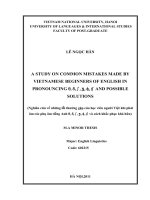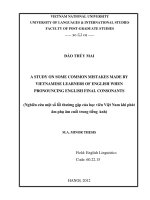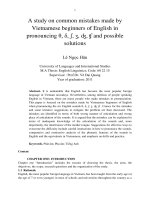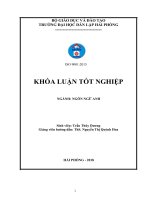a study on some common mistakes made by vietnamese learners of english when pronouncing english final consonants = nghiên cứu một số lỗi thường gặp của học viên việt nam khi phát âm phụ âm cuối trong tiếng anh
Bạn đang xem bản rút gọn của tài liệu. Xem và tải ngay bản đầy đủ của tài liệu tại đây (1.23 MB, 58 trang )
VIETNAM NATIONAL UNIVERSITY
UNIVERSITY OF LANGUAGES & INTERNATIONAL STUDIES
FACULTY OF POST-GRADUATE STUDIES
ĐÀO THÚY MAI
A STUDY ON SOME COMMON MISTAKES MADE BY
VIETNAMESE LEARNERS OF ENGLISH WHEN
PRONOUNCING ENGLISH FINAL CONSONANTS
(Nghiên cứu một số lỗi thường gặp của học viên Việt Nam khi phát
âm phụ âm cuối trong tiếng Anh)
M.A. MINOR THESIS
Field: English Linguistics
Code: 60.22.15
HANOI, 2012
VIETNAM NATIONAL UNIVERSITY
UNIVERSITY OF LANGUAGES & INTERNATIONAL STUDIES
FACULTY OF POST-GRADUATE STUDIES
ĐÀO THÚY MAI
A STUDY ON SOME COMMON MISTAKES MADE BY
VIETNAMESE LEARNERS OF ENGLISH WHEN
PRONOUNCING ENGLISH FINAL CONSONANTS
(Nghiên cứu một số lỗi thường gặp của học viên Việt Nam khi phát
âm phụ âm cuối trong tiếng Anh)
M.A. MINOR THESIS
Field: English Linguistics
Code: 60.22.15
Supervisor: Huỳnh Anh Tuấn, Ph.D
HANOI, 2012
iv
TABLE OF CONTENTS
DECLARATION i
ACKNOWLEDGEMENTS ii
ABSTRACT iii
TABLE OF CONTENTS iv
LIST OF TABLES v
LIST OF FIGURES vi
PART ONE: INTRODUCTION 1
1. RATIONALE 1
2. AIMS OF THE RESEARCH 2
3. RESEARCH METHODOLOGY 2
4. SCOPE OF THE STUDY 3
5. DESIGN OF THE STUDY 4
PART TWO: DEVELOPMENT 5
Chapter 1: THEORETICAL BACKGROUND AND LITERATURE REVIEW 5
I. THEORETICAL BACKGROUND 5
I.1. General descriptions of stop consonants 5
I.2. Phonological characteristics and articulation of the sounds /p/, b/, /t/, /d/, /k/ and
/g/ 6
I.3. Vietnamese final stop consonants vs. English final stop consonants 10
II. LITERATURE REVIEW 11
Chapter 2: RESEARCH METHODOLOGY 19
2.1. Research questions 19
2.2. The informants of the study 19
2.3. Research method 20
Chapter 3: DATA ANALYSIS: FINDINGS AND DISCUSSIONS 23
3.1. The recordings 23
3.2. The survey questionnaire 29
PART THREE: CONCLUSION 38
1. Summary 38
2. Concluding remarks 38
3. Pedagogical Implications 41
4. Limitations and Suggestions for further research 42
REFERENCES 43
APPENDIX 1 I
v
APPENDIX 2 IV
vi
LIST OF TABLES
Table 1: Stop consonants chart
Table 2: Sounds mispronounced by Vietnamese students
Table 3: Occurrence of mispronunciation across the 30 informants
Table 4: Percentages of informants producing sound omission
Table 5: Percentages of informants producing sound deviation
Table 6: Number of informants producing mistakes
Table 7: Causes of the informants‟ mispronunciation
Table 8: Informants‟ frequencies of applying pronunciation improving strategies
Table 9: Teachers of informants‟ frequencies of applying strategies to improve
learners‟ speaking English
vii
LIST OF FIRURES
Figure 1: Place and manner articulation of the sound /p/
Figure 2: Place and manner articulation of the sound /b/
Figure 3: Place and manner articulation of the sound /t/
Figure 4: Place and manner articulation
of
the
sound /d/
Figure 5: Place and manner articulation of the sound /k/
Figure 6: Place and manner articulation of the sound /g/
Figure 7: Informants‟ years of learning English
Figure 8: Informants‟ perception of the role of pronunciation
Figure 9: Informants‟ difficulty in speaking English
Figure 10: Informants‟ opinion about the causes of mistakes
Figure 11: Percentage of informants applying pronunciation strategies
Figure 12: Informants‟ ideas about their teachers‟ pronunciation teaching
strategies
1
PART ONE: INTRODUCTION
1. RATIONALE
Our world is developing every hour and international cooperation is one of the important
strategies of each country to promote its socio-economic development. To integrate
successfully into the global economy, foreign language is considered to be indispensable.
Understanding the importance of foreign languages in general and of English in
particular, the Vietnamese government has set up a curriculum for English learning for
children from 6 years old onwards. The number of English language centers has been
remarkably increasing during the past two decades. Whereas English is an urgent
requirement for young graduates to get a good job, many of them find it difficult to speak
English properly to meet this demand.
It is widely recognized that success in language learning is the ability to communicate
with others in a way that makes them fully understand what the speaker says and his
intended meaning. There are many Vietnamese students who have been learning English
for many years but find it rather difficult to sustain a conversation. This is because the
focus is only on grammar and vocabulary when they are in high school. As a result, they
have good knowledge of these two components, but their pronunciation is poor. Thus, it is
easy to understand that pronunciation is one of the most important factors affecting
successful communication. Also, it is one of the reasons for communication breakdown.
If the speaker pronounces the words incorrectly, the listener will get confused and find the
speaking incomprehensible; or he may understand you in another way assuming
something different from what is meant. Therefore, pronunciation has great influence on the
success of oral communication. It is said that the better your pronunciation is, the better you
will be treated and the more comfortable people will feel when dealing with you.
At university level, it is really important to have good pronunciation because it helps
students to be confident in taking oral exams. Certainly, examiners will be impressed with
examinees‟ vocal clarity, and students‟ presentation will sound more professional and
persuasive to listeners.
2
These premises have urged me into carrying research into the most common mistakes
made by senior non- English major students at Thai Nguyen University of Economics and
Business Administration (TUEBA) when pronouncing 6 English final consonants. The
research ultimately aims at finding out solutions and to help Vietnamese learners of
English overcome these mistakes.
2. AIMS OF THE RESEARCH
Making mistakes in pronouncing final consonants is regarded as very common for
students when they learn English. These difficulties are challenges for Vietnamese
learners in general and for senior year non- English major students in particular if they do
not find the most suitable study method for themselves. In this study, the author
investigates the most common mistakes made by those learners to:
Identify the most common mistakes in pronouncing English final consonants: /p/,
/b/, /t/, /d/, /k/, and /g/ by senior non-English major students at Thai Nguyen
University of Economics and Business Administration;
Find out the causes of these mistakes;
Provide some strategies to help students avoid mispronunciation.
Hopefully, this research will provide one more reference source for teachers of English as
a second language when they teach pronunciation. At the same time, this will also be
useful to Vietnamese students of English in correcting their mistakes and improving
pronunciation skills.
3. RESEARCH METHODOLOGY
Research questions
The study addresses the following four questions:
1. Do Vietnamese learners of English make mistakes when pronouncing
English final stop consonants?
2. What are the most common mistakes students often make?
3. What are the causes of the mispronunciation?
3
4. What are the possible solutions to help learners correct these mistakes?
Research context
The research was conducted on 150 senior English non- major students of joint training
program between Thai Nguyen University of Economics and Business Administration
and Daegu Cyber University. These students had a lot of chances to improve their English
proficiency because most of the courses were taught in English.
Research method
The study was conducted via a survey in which two instruments of data collection were
used: recording the informants‟ pronunciation of selected isolated words and words
within utterances, sentences and texts to find out the common pronunciation mistakes
with stop final consonants and a questionnaire to investigate the causes of the mistakes
and the solutions to the problems. The data analysis is quantitative.
4. SCOPE OF THE STUDY
The English alphabet is based on Latin and contains twenty six letters. However, the
English sound system consists of forty four phonemes: twenty four consonants, twelve
pure vowels (monothongs), and eight diphthongs. In general, Vietnamese learners have
difficulties in pronouncing some of the English sounds only but not all of them.
It is necessary to make a distinction between errors and mistakes. According to
“Longman Dictionary of Language Teaching & Applied Linguistics” by Richards. J,
Platt. J and Platt. H (1992), errors results from incomplete knowledge but mistakes are
made when writing or speaking and caused by lack of attention, fatigue, carelessness or
some other aspect of performance.
Due to time constraints, the length of thesis (minor thesis) and the researcher‟s
knowledge, it is impossible for the researcher to study all the mistakes made by students
when producing English consonants. Therefore, this study only focuses on finding out the
most typical mistakes made by some senior non-English major students at TUEBA when
pronouncing the six English stop consonants /p/, /b/, /t/, /d/, /k/ and /g/ at final position of
words with the following reasons:
4
There has not yet been any research on all the six stop consonants. Several authors
have studied one or two certain consonants of the six only.
Six stop consonants are not so difficult to produce, however students seem to omit
these sounds at final position. Basing on my teaching experience, I find that most
students often make mistakes with some plosive consonants like /t/, /d/, /p, /b/ and
the most common mistakes are sound omission and sound deviation. The said
reasons have motivated me to carry out this study to find out the mistakes as well as
to offer strategies to help students to overcome this problem.
5. DESIGN OF THE STUDY
The thesis comprises three parts:
The first part is the introduction which includes the rationale, aims, research
methodology, scope and design of the study.
The second part, development, is divided into three chapters. Chapter one provides the
theoretical background and literature review of the study. The theoretical background
presents the general description of stop consonants, the phonological characteristics and
articulation of the sounds /p/, /b/, /t/, /d/, /k/ and /g/ and a comparison between
Vietnamese final consonants and English final consonants. The literature review discusses
previous works related to consonant pronunciation among second language learners.
Chapter two is devoted to the methodology of the study in which the research questions
are raised, the informants of the study are discussed and the research method is given with
the data collection instruments, the data analysis methods and data collection procedure.
Chapter 3, data analysis: findings and discussion, analyses the data collected from the
recordings and the questionnaire and presents the findings and discussion of the study.
The final part is the conclusion including a summary of the study, concluding remarks,
pedagogical implications and suggestions for further research.
5
PART TWO: DEVELOPMENT
Chapter 1: THEORETICAL BACKGROUND AND LITERATURE REVIEW
This chapter provides some key concepts as the theoretical background for the research.
The general description of 6 stop consonants, the phonological characteristics and
articulation of these sounds and a comparison of Vietnamese final stop consonants and
English final stop consonants are included in the theoretical background. The second part
of this chapter is devoted to the review of some works related to this research.
I. THEORETICAL BACKGROUND
I.1. General descriptions of stop consonants
Roach, P (1990) defined that a plosive consonant is a consonant articulation with the
following characteristics:
1. The closing stage, during which the articulating organs move together in order to form
the obstruction; in this stage there is often an on-glide or transition audible in a
preceding sound segment and visible in an acoustic analysis as characteristic curve of
formants of the preceding sound;
2. The hold or compression stage, during which lung action compresses the air behind the closure;
this stage may or may not be accompanied by voice, i.e. vibration of the vocal cords;
3. The release or explosion stage, during which the organs forming the obstruction part
rapidly, allowing the compressed air to escape abruptly; if stage (2) is voiced, the vocal
cord vibration may continue in stage (3); if stage (2) is voiceless, stage (3) may also be
voiceless (aspiration) before silence or before the onset of voice.
The general descriptions of stop consonants can be illustrated in the following table:
Place
Manner
Bilabial
Labio-
dental
Inter-
dental
alveola
r
Alveo-
palatal
velar
stops
vcls
p
t
k
vd
b
d
g
Table 1: Stop consonants chart
(Vcls = voiceless vd = voiced)
Avery and Ehrlich (2010:26)









